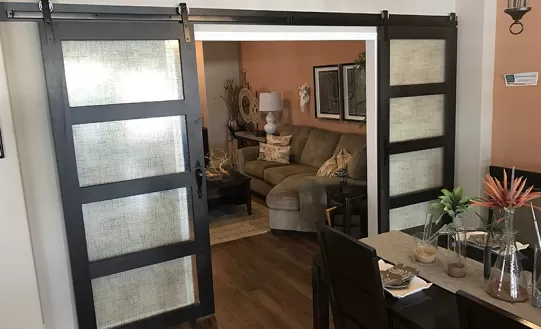As Earth Month winds down, we figured it was time to take a look at some of the elements involved in purchasing a more environmentally-friendly home while helping our second favorite mother – Mother Earth. Conveniently, these suggestions can green up your pocketbook too.
Here are some big options to consider but keep reading for smaller projects that can be done after you purchase your new home (or in the home you currently live in). Some are easy and others more complicated, but all are designed to save you money, while helping the environment.
The Big Earth-Friendly Stuff
- Here comes the sun: Take advantage of our state’s exceptionally sunny weather to provide your own energy, while minimizing non-renewable energy use. Solar panels convert sunlight to AC energy that can be used throughout the home. They’ll save you money, but there is the installation cost to consider. The U.S. Department of Energy has a handy-dandy calculator that will give you a better idea of how much money you can save by going solar, depending on your location and property type. For more on this, check out our blog: Is Solar Power A Good Thing In Nevada — This Time Around?
- How stuff is made: Some building materials are more energy-efficient than others which means the home you’re considering buying could start saving you money right off the bat. HowStuffWorks.com shares information on the pros and cons of steel, concrete forms, plant-based polyurethane rigid foam, straw bales, structural insulated bales, recycled wood/plastic composite lumber, vacuum insulation panels and adobe.
- The roof over your head: As with other parts of your home, certain types of roofs will keep heat out of your house while better maintaining the internal temperature. Mother Earth News shares information on eco-friendly roof options, including recycled and wood shingles, shakes, slate and clay tiles, and metal, rubber and cool roofs.
The government is also a fan of these energy-efficient options, so be sure to check out any applicable federal tax credits.
Some Bite-Sized Efficiency Projects
Energy.gov shares information on attributes you should look for in a new home, as well as improvements that you can make to an existing home, for energy efficiency.
- Appliances and home electronics: Using energy-efficient appliances will save you energy and money, and this goes beyond the kitchen and laundry room, where you should look for the ENERGY STAR label, which has to meet federal standards. If you have a computer set-up in your home, make sure everything (monitor, printer, etc.) is plugged into a surge protector and turn it off every night. This avoids “vampire loads” that continue to use electricity even when items are turned off. This applies to TVs, stereos, DVD and videogame players as well.
-
Energy-saving kitchen tips: Shared by Energy.gov, all of these are pretty easy to implement.
- Place the faucet lever on the kitchen sink in the cold position when using small amounts of water. Placing the lever in the hot position draws hot water even though it may never reach the faucet.
- Look for a natural gas oven or range with an automatic, electric ignition system, which saves gas since a pilot light is not burning continuously.
- Look for blue flames in natural gas appliances; yellow flames indicate the gas is burning inefficiently and an adjustment may be needed. If you see yellow flames, consult the manufacturer or your local utility.
- Keep range-top burners and reflectors clean; they will reflect the heat better and save you energy.
- Cover your pot or use a kettle to boil water; it's faster and uses less energy.
- Match the size of the pan to the heating element.
- Use small electric pans, toaster ovens, or convection ovens for small meals rather than your large stove or oven. A toaster or convection oven uses one-third to one-half as much energy as a full-sized oven.
- Water heating: Water heating is the second biggest expense in your home (after air heating and cooling), with the average household spending between $400 and $600 each year. Ensuring you have the right kind of water heater is definitely worth some attention. Click here for an Energy.gov provides an easy-to-read infographic outlining the different types of water heaters and which will work best for you.
-
Water: There are a number of products and habits that can save water, from water-efficient showerheads to low-flow taps and dual flush toilets; and, of course, better managing our outdoor watering habits. The websites for Southern Nevada Water Authority (SNWA) and Truckee Meadows Water Authority (TMWA) both share tips on water efficiency.
- Insulation and air sealing: Stop the leaks! Reduce air leaks to better manage heat and air conditioning and reduce those pesky energy bills. Much of this can be done easily with caulking, weather stripping and keeping our fireplace flue dampers closed when not in use. Energy.com has more tips on sealing your home, and find out more about the Nevada Housing Division’s weatherization assistance program, which provides help for eligible clients free of charge.
- Lighting: After years of hearing your dad tell you to turn off the lights when you’re not using them, you’re well aware of that important advice, but you can also change out your lightbulbs to save even more energy. Energy-efficient lighting comes in all the light levels and color choices you’ve had before, so you won’t have to give up your preferences to save energy.
- Windows, doors and skylights: Ensuring these are as energy-efficient as possible can reduce heating, cooling and lighting. There are many options, but they can get spendy, so you’ll want to figure out what makes the most sense for your home and budget. However, you can start saving energy right now by remembering to close your curtains at night to protect against cold drafts; ensuring the window stripping is in good shape and closing your south- and west-facing curtains during the day.
Know What You’ve Got
Your hometown utility provider wants you to be energy-efficient and save some $$. Once you’re in your new home, NVEnergy can visit and give you a free energy assessment, sharing information on everything from your filters and air vents to your insulation and windows.
If you want to do it yourself first, you can find the Free Online Energy Assessment on your NVEnergy dashboard. It provides you with details on how your home is using energy including:
- An appliance breakdown (kWh, $ or percentages) for every billing cycle
- Tracking how much energy you’re consuming relative to other similar homes by zip code and home type (single family home vs. apartment)
- Personalized recommendations on how to reduce your energy consumption for the whole home and by each appliance category
Understanding how your home is heated and cooled can help you better adjust your habits to save energy. If you own (or are buying) your home, check out NVEnergy’s free smart thermostat, which learns your temperature preferences and can be controlled through your smart phone or pad.
It’s free, easy and includes:
- The latest energy-efficient technology, including up to four smart thermostats, worth about $300 each
- Free professional installation
- Free energy efficiency software to manage your home’s temperature from your favorite mobile device or computer
- 24/7 customer care support
Let’s not forget manufactured housing, as all new manufactured homes are built to U.S. Department of Housing and Urban Development (HUD) Code, so they start out pretty energy-efficient. If you’re considering purchasing an existing manufactured home, here are some things to consider from Energy.gov’s article on Energy-Efficient Manufactured Homes. As a reminder, our Home Is Possible down payment assistance programs can be used for the purchase of manufactured homes.
Has all this talk about earth-friendly living got you dreaming of a new home? If so, your first step should be checking out the many different Home Is Possible down payment assistance programs we offer to see how we can help make that dream a reality.


